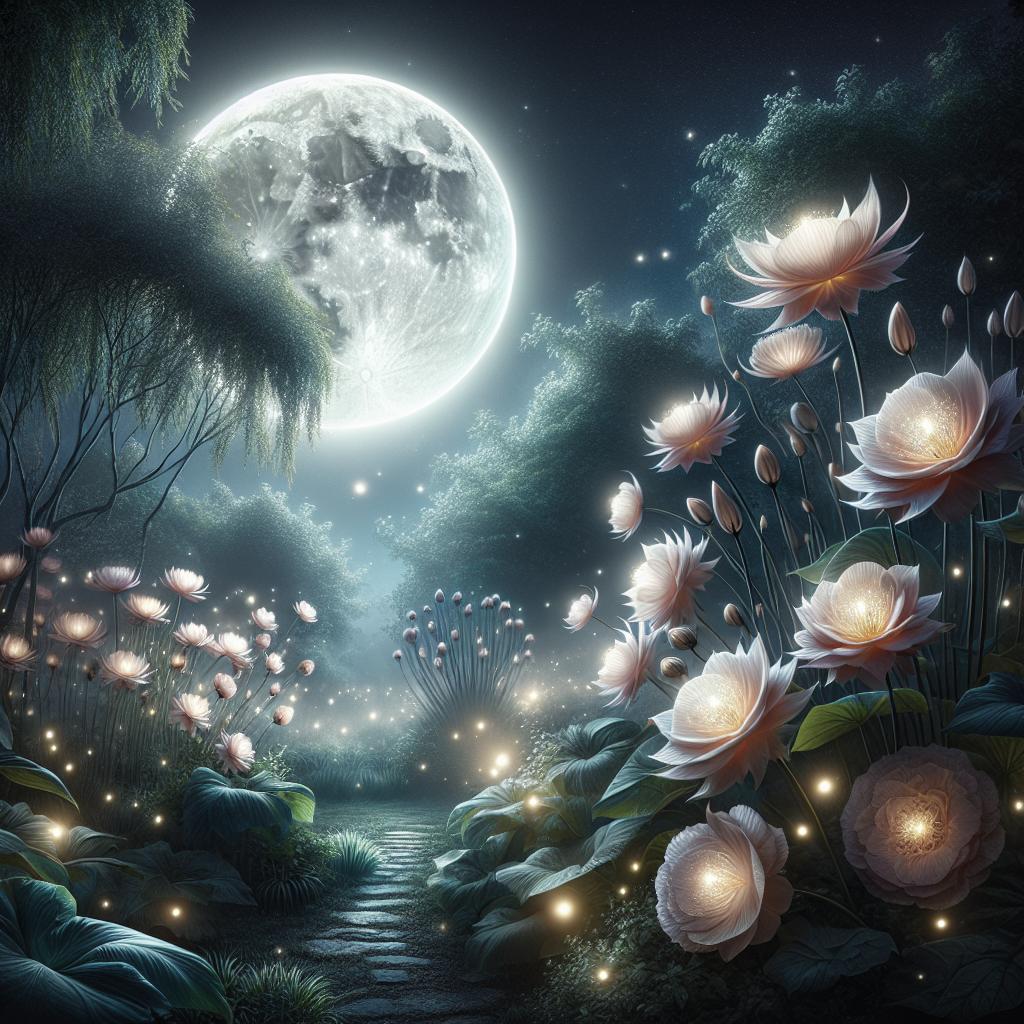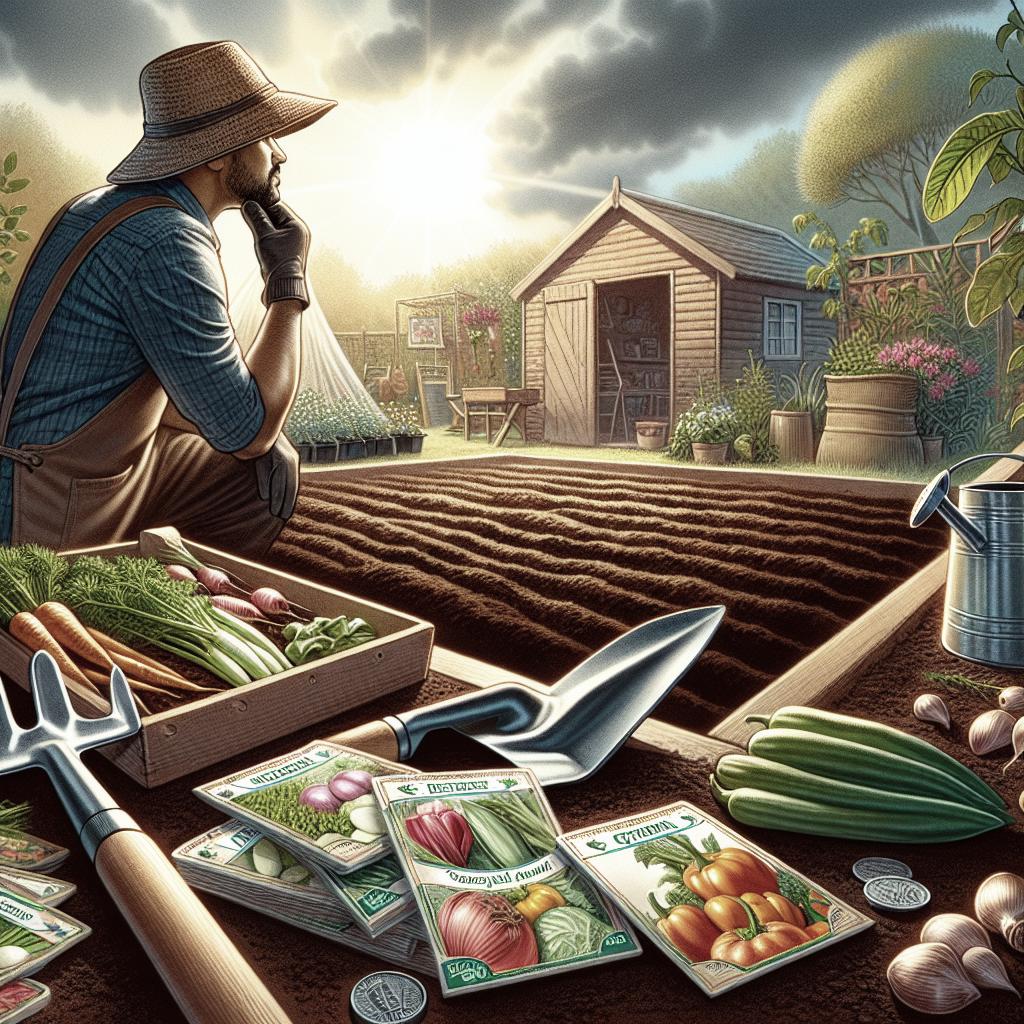“`html
How to Create a Moon Garden with Night-Blooming Plants
Welcome to the enchanting world of moon gardens, where night-blooming plants take center stage. This blog post explores how to create a mystical nocturnal oasis that comes alive under the moon’s gentle glow. We’ll delve into the selection of plants that thrive at night, with a special focus on night-blooming flowers, white-and-silver foliage, ornamental grasses, variegated plants, and highly fragrant species that lend a sensory charm to your garden. Additionally, we’ll offer magical tips to enhance your moon garden’s allure and practical advice on caring for it. Whether you’re an experienced gardener or a night-sky enthusiast, this guide will help transform your outdoor space into a night-time paradise.
What Is a Moon Garden?
A moon garden is a unique type of garden designed to be enjoyed in the moonlight. Unlike traditional gardens that primarily focus on daytime blooms, moon gardens showcase plants with flowers that open at dusk or display reflective shades in low-light conditions. The goal is to create a serene and atmospheric setting perfect for nocturnal enjoyment.
Moon gardens often incorporate elements that enhance their nighttime appeal, such as water features that reflect the moonlight, paths illuminated by soft, ambient lighting, and seating areas for contemplation. Beyond their beauty, they can also provide a haven for night-pollinators like moths and bats, supporting local biodiversity.
Moon Garden Flowers and Plants
Night-Blooming Flowers
Night-blooming flowers are the stars of any moon garden. These plants reserve their bloom for the evening, providing bursts of color and fragrance after sunset. Species such as Moonflower (Ipomoea alba), Evening Primrose (Oenothera biennis), and Night Phlox (Zaluzianskya capensis) are perfect choices, captivating with their large, luminous blooms and sweet scents.
These flowers not only add aesthetic appeal but also create an inviting environment for nocturnal pollinators. Their luminous petals often reflect the moonlight, adding a magical glow to the garden space, and enticing night-flying insects.
White-and-Silver Plants
In a moon garden, white and silver foliage can be as impactful as vibrant blooms. These shades stand out in dim lighting, catching the moon’s rays and adding a silvery luminescence to your garden. Lamb’s Ear (Stachys byzantina) and Dusty Miller (Senecio cineraria) are excellent options for their velvety, reflective leaves.
White and silver plants also serve as a neutral backdrop that enhances the visibility of other colorful night-blooming flowers. Moreover, the textures of these plants add depth and interest when observed under soft moonlight.
Ornamental Grasses
Ornamental grasses can bring movement and texture to a moon garden. Their swaying stalks catch the evening breezes, creating soothing sounds and mesmerizing patterns in the moonlight. Varieties such as Maiden Grass (Miscanthus sinensis) and Blue Fescue (Festuca glauca) offer graceful forms and subtle hues.
These grasses create a dynamic landscape with their feathery plumes and delicate movements, enhancing the garden’s tranquility. They are a low-maintenance option that offers structure and elegance to your moonlit sanctuary.
Variegated Plants
Variegated plants with their unique patterns and contrasting colors add an artistic element to a moon garden. Their lighter-colored edges and intricate designs are highlighted under moonlight, creating a visual spectacle. Hostas and variegated ivies are popular choices for their foliage’s stunning patterns.
These plants offer variety beyond plant forms and colors, adding another layer of visual interest that engages viewers, both day and night. Their adaptability to different lighting conditions makes them a versatile option for moon garden compositions.
Highly Fragrant Plants
No moon garden is complete without the enticing aroma of fragrant plants. Species like the sweet-smelling Jasmine (Jasminum polyanthum), the sensory delight of Gardenias (Gardenia jasminoides), and the intoxicating scent of Night-Blooming Jasmine (Cestrum nocturnum) are perfect for adding olfactory enchantment.
The fragrances released in the cool night air draw attention and deepen the sensory experience of the garden, creating a peaceful environment ideal for relaxation and reflection.
Blue-Toned Plants
Blue-toned plants add tranquility to the moon garden with their cool, calming hues. They complement the whites and silvers, offering a sense of depth and a soothing vibe. Blue Salvia, Periwinkle, and certain varieties of Blue Lobelia provide these understated tones, adding elegance and composure to the garden.
These plants enhance the ethereal quality of a moon garden, providing a serene and balanced aesthetic that is both restful and dreamy.
Tips for Making Your Moon Garden More Magical
To enhance the allure of your moon garden, consider integrating reflective surfaces such as mirrors, glass sculptures, or water features. These elements can magnify the light and create interesting patterns and illusions under the moon’s glow.
The incorporation of subdued lighting, like fairy lights, lanterns, or solar path lights, can highlight garden features and add a magical ambiance without overpowering the natural beauty of the plants.
Consider including a comfortable seating area where you can relax and enjoy the sights and sounds of your moon garden. Choose materials and designs that integrate seamlessly with your garden’s aesthetic to maintain a cohesive, tranquil environment.
Caring for Your Moon Garden
Caring for a moon garden involves regular maintenance practices similar to those of any other garden. Ensure proper soil preparation and watering routines based on the plant types selected. It’s vital to understand the watering needs of your plants, especially those that thrive at night.
Regular pruning and deadheading will help maintain the health and appearance of your garden. Use nutrient-rich soil and organic fertilizers to promote growth and resilience against pests. Monitor your plants frequently for disease or pests, using environmentally friendly treatments whenever possible.
Creating a moon garden is an ongoing process. Experiment with different species, arrangements, and accessories until you find the perfect balance that suits your space and style. Enjoy the journey as much as the destination, letting the garden evolve with your ideas and inspirations.
Future Prospects
| Aspect | Details |
|---|---|
| Moon Gardens | Designed for enjoyment under moonlight, host night-blooming plants and reflective elements. |
| Key Plant Types | Include night-blooming flowers, white-and-silver foliage, ornamental grasses, variegated and fragrant plants, and blue-toned flora. |
| Enhancements | Add reflective surfaces, subdued lighting, and seating areas for a magical experience. |
| Maintenance | Focus on regular care including watering, pruning, and using nutrient-rich soil for plant health. |
“`

